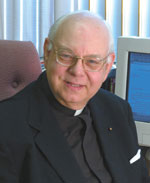Sixth Sunday in Ordinary Time / Msgr. Owen F. Campion
The Sunday Readings
 The first reading for Mass this weekend comes from the Book of Leviticus. In sequence, Leviticus is the fourth book in modern biblical translations. As such, it is part of the Pentateuch. The Pentateuch includes the five books of the Bible attributed to Moses. These five books are also called the Torah.
The first reading for Mass this weekend comes from the Book of Leviticus. In sequence, Leviticus is the fourth book in modern biblical translations. As such, it is part of the Pentateuch. The Pentateuch includes the five books of the Bible attributed to Moses. These five books are also called the Torah.
The Torah forms the fundamental law and philosophy of Judaism, both in current understandings and in ancient practices as well.
In this reading, God speaks to Moses and to Aaron, Moses’ brother. The topic is leprosy. It is not known whether these references to leprosy in the Scriptures referred to what is known today as Hansen’s disease or to some other illness. Regardless of the exact scientific nature of what the ancients called leprosy, the problem was chronic and severe.
An entire social system developed around the disease. Victims were outcasts. They were brutally shunned, often had to forage or beg for food and search for any shelter they could find.
Ancient Jews would never blame God for such a serious malady. God was seen as good, loving and merciful. The ancient Hebrews saw human sin as ultimately the cause of all earthly misery, including illness.
St. Paul’s First Epistle to the Corinthians furnishes this liturgy with its second reading. In this reading, the great Apostle counsels the Christians of Corinth never to offend anyone, Jew or Gentile. This advice reveals that the Corinthian Christian community involved both kinds of people. Jews lived in places throughout the Roman Empire, not just in the Holy Land.
Paul urges that the Christians follow his example, because he imitates Christ.
For its last reading, the Church gives us a passage from the Gospel of St. Mark.
In this reading, a leper approaches Jesus, asking for a cure. The same attitude about leprosy applied among Jews at the time of Jesus as it did among Jews in the days of Moses.
Jesus cured the man, the Lord being “moved with pity,” according to Mark (Mk 1:41). This cure came when Jesus touched the man. Symbolic touching was important in those days, as it is important today in the liturgy. It represents contact and transferal. In ordinations, the ordaining bishop lays his hands upon the candidates to be ordained bishop, priest or deacon. At weddings, the bride and bridegroom hold each other’s hands when exchanging their nuptial vows.
Jesus transmitted the healing power of God to the man through this touch. Then, Jesus spoke the miraculous words of healing.
The Lord ordered the man to go to the Jewish priests, since they could reinstate him in society if they saw he was free of disease.
Reflection
In these weeks after Christmas, in the feast of the Epiphany of the Lord and the feast of the Baptism of the Lord, the Church has continued to introduce us to the person and ministry of Jesus and to explain the marvel of the coming of the Son of God.
This weekend, the horror of leprosy, as it was regarded by Jews long ago, is critical to understanding the readings. It is necessary to apply basic implications to ourselves.
Like leprosy, sin leads to death. Furthermore, it separates us from the one community of faith in the Lord. We sinners are outcasts and strangers, left to struggle in the best way that we can, and this is the problem.
Living in sin is to be in a world in which selfishness reigns. Jesus, always moved by love, cures us and reinstates us, as it were, by forgiving our sins. Forgiven, we enter again the family of God. Life, not death, is our destiny.
The key is having faith, repenting and living according to the Lord’s model. †
 The first reading for Mass this weekend comes from the Book of Leviticus. In sequence, Leviticus is the fourth book in modern biblical translations. As such, it is part of the Pentateuch. The Pentateuch includes the five books of the Bible attributed to Moses. These five books are also called the Torah.
The first reading for Mass this weekend comes from the Book of Leviticus. In sequence, Leviticus is the fourth book in modern biblical translations. As such, it is part of the Pentateuch. The Pentateuch includes the five books of the Bible attributed to Moses. These five books are also called the Torah.